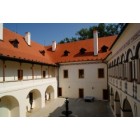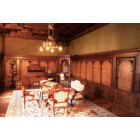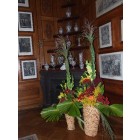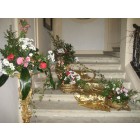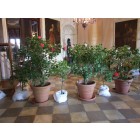Blansko
The charming Renaissance chateau is the dominant landmark in the town of Blansko. A number of famous people, such as the doctor and archaeologist Jindřich Wankel and Austrian writer Ferdinand von Saar, have stayed here. The most famous person connected with Blansko Chateau is Caroline Meineke, wife of the future King of England William IV and heroine of an ancient tale of unrequited love. Cast-iron sculptures inspired primarily by ancient times and the Renaissance can be found in the chateau park which also contains many old trees. The chateau is now home to the town museum, whose permanent exhibitions reflect the tradition of the iron industry and the production of artistic castings in Blansko. It also features interesting historical interiors and documentation on the history of research in the Moravian Karst.
The chateau stands on the site of an original Gothic feudal court mentioned in sources from the fourteenth century. The building has four wings with a rectangular inner courtyard with pillared arcades. The chateau’s Renaissance appearance dates back to the beginning of the seventeenth century. It was built in 1604–1605 by Jan Žalkovský of Žalkovice. It has undergone numerous alterations since that time. In 1695, the Gellhorns built the chateau tower and clock, while the interior layout was altered during the time of the Salms in the nineteenth century. General repairs to the chateau were performed in 1969 with the aim of restoring the purity of the building’s Renaissance style.
Rájec nad Svitavou
An extremely valuable complex in architectural terms with luxurious interiors. The small castle in Rájec was converted into a Renaissance chateau in 1570 by Bernart Drnovský of Drnovice. The Roggendorfs were other important owners of the chateau. The chateau was destroyed in a fire in 1756. Shortly afterwards, in 1763, the Roggendorfs sold the Rájec estate to the Salm family. The Salms had a Classicist chateau built here in the French style, inspired by the architecture of the age of Louis XVI, in the years 1763–1769.
There is a period exhibition featuring a number of large halls in the interior. The Salm family picture collection on the first floor of the chateau, dominated by paintings by the Dutch and Flemish masters, is extremely valuable. The large Empire library with more than sixty thousand volumes is also famous. The chateau is set in an English landscaped garden established in 1767. Annual flower shows in the charming chateau interiors have become something of a tradition, with camellia flowers at the end of February and dahlias at the end of the summer. Night tours of the chateau have also become extremely popular.
Křtiny
The former residence of the Premonstratensians from Zábrdovice in Brno is closely linked to the local Church of the Name of the Virgin Mary. The monastery in Křtiny enjoyed its greatest fame in the second half of the eighteenth century soon after the consecration of the church. It was, however, dissolved by Emperor Joseph II soon afterwards. The church continued to serve its purpose, though the property of the monastery was sold off. New owners arrived – the Dietrichsteins, followed by the Bubens of Litice and the Taubers. In 1894, Křtiny Chateau was obtained by John II of Liechtenstein, who intended to restore it and donate it to the village to serve as a school or a hospital. Křtiny, however, would not accept this gift in fear of the large costs involved. In 1923, Křtiny Chateau was also taken over when the Liechtensteins’ Adamov estate was taken over by the University of Agriculture in Brno. Since the nineteen fifties, the building has been used for practical education on the university estate. At the beginning of the nineteen eighties, the chateau was given over to the administration of the University Forestry Enterprise, Křtiny. At the present time, the chateau serves as a social and education centre of Mendel University in Brno. It is not normally open to the public, though it may be used for congress tourism. The chateau is available to any organisation interested in holding educational, social and cultural events, including celebrations of all kinds. In view of the vicinity of the church, the chateau specialises, in particular, in the organisation of wedding receptions and has a special honeymoon suite. The chateau offers a large congress hall and several types of conference rooms and lounges. It also provides accommodation and has a non-smoking restaurant.
The charming Renaissance chateau is the dominant landmark in the town of Blansko. A number of famous people, such as the doctor and archaeologist Jindřich Wankel and Austrian writer Ferdinand von Saar, have stayed here. The most famous person connected with Blansko Chateau is Caroline Meineke, wife of the future King of England William IV and heroine of an ancient tale of unrequited love. Cast-iron sculptures inspired primarily by ancient times and the Renaissance can be found in the chateau park which also contains many old trees. The chateau is now home to the town museum, whose permanent exhibitions reflect the tradition of the iron industry and the production of artistic castings in Blansko. It also features interesting historical interiors and documentation on the history of research in the Moravian Karst.
The chateau stands on the site of an original Gothic feudal court mentioned in sources from the fourteenth century. The building has four wings with a rectangular inner courtyard with pillared arcades. The chateau’s Renaissance appearance dates back to the beginning of the seventeenth century. It was built in 1604–1605 by Jan Žalkovský of Žalkovice. It has undergone numerous alterations since that time. In 1695, the Gellhorns built the chateau tower and clock, while the interior layout was altered during the time of the Salms in the nineteenth century. General repairs to the chateau were performed in 1969 with the aim of restoring the purity of the building’s Renaissance style.
Rájec nad Svitavou
An extremely valuable complex in architectural terms with luxurious interiors. The small castle in Rájec was converted into a Renaissance chateau in 1570 by Bernart Drnovský of Drnovice. The Roggendorfs were other important owners of the chateau. The chateau was destroyed in a fire in 1756. Shortly afterwards, in 1763, the Roggendorfs sold the Rájec estate to the Salm family. The Salms had a Classicist chateau built here in the French style, inspired by the architecture of the age of Louis XVI, in the years 1763–1769.
There is a period exhibition featuring a number of large halls in the interior. The Salm family picture collection on the first floor of the chateau, dominated by paintings by the Dutch and Flemish masters, is extremely valuable. The large Empire library with more than sixty thousand volumes is also famous. The chateau is set in an English landscaped garden established in 1767. Annual flower shows in the charming chateau interiors have become something of a tradition, with camellia flowers at the end of February and dahlias at the end of the summer. Night tours of the chateau have also become extremely popular.
Křtiny
The former residence of the Premonstratensians from Zábrdovice in Brno is closely linked to the local Church of the Name of the Virgin Mary. The monastery in Křtiny enjoyed its greatest fame in the second half of the eighteenth century soon after the consecration of the church. It was, however, dissolved by Emperor Joseph II soon afterwards. The church continued to serve its purpose, though the property of the monastery was sold off. New owners arrived – the Dietrichsteins, followed by the Bubens of Litice and the Taubers. In 1894, Křtiny Chateau was obtained by John II of Liechtenstein, who intended to restore it and donate it to the village to serve as a school or a hospital. Křtiny, however, would not accept this gift in fear of the large costs involved. In 1923, Křtiny Chateau was also taken over when the Liechtensteins’ Adamov estate was taken over by the University of Agriculture in Brno. Since the nineteen fifties, the building has been used for practical education on the university estate. At the beginning of the nineteen eighties, the chateau was given over to the administration of the University Forestry Enterprise, Křtiny. At the present time, the chateau serves as a social and education centre of Mendel University in Brno. It is not normally open to the public, though it may be used for congress tourism. The chateau is available to any organisation interested in holding educational, social and cultural events, including celebrations of all kinds. In view of the vicinity of the church, the chateau specialises, in particular, in the organisation of wedding receptions and has a special honeymoon suite. The chateau offers a large congress hall and several types of conference rooms and lounges. It also provides accommodation and has a non-smoking restaurant.


